Country Info Peru
Currency
Peruvian Sol
1 € are about 3,70 PEN
Entry Peru
Coming from Chile (Arica), leave the first official building on the left and pass it on the right. Park your motorbike or car in front of the next big white building. For larger vehicles/ buses/ expedition vehicles etc. there is a parking lot on the right.
First you walk right of the building through the border and go into the canteen (comedor) on the right side and buy a document at the cash desk (we don't know the exact name). Cost approx. 1 €.
Fill in this document (information about the drivers and the vehicles will be entered there). The document is needed during the departure from Chile and/or entry to Peru and is stamped several
times in different places and retained at the end.
Next you enter the building through the left entrance "PDI Chile". There you will be stamped out of Chile (stamp in passport).
Then you will be stamped into Peru (stamp in the passport). The entrance is in the middle of the building.
Then you go to one of the two counters in front of the building with your vehicle documents. Here the document you bought at the beginning is retained.
For the temporary import permit of the KFZ / motorcycle (TIP), you go to the left side of the building. Entrance "CIT". After giving some vehicle specific data, you get the TIP.
At the end you drive to the inspectors you passed at the beginning to the canteen (comedor). We had to unload and show everything, drug dogs sniffed at all suitcases and bags and finally we had to push everything through the scanner (like in an airport) in the room to the left of it (luckily we didn´t have to unload our heavy aluminium suitcases, they were allowed to stay on the motorcycle).
When entering Peru, please note that no organic substances (fruit, vegetables, honey, wood etc.) may be imported to Peru.

Leaving Peru
The departure went without problems. We travelled from Huaquillas / Peru (shortly after Tumbes) to Ecuador. You drive through a checkpoint into the complex. In the middle on the right side the migration takes place. The leaving of Peru and the entry to Ecuador take place at two counters which are next to each other. For the departure of the motorbike / car you have to walk to the first building on the right side. There you hand in the TIP of Peru.

Motor vehicule insurance
The insurance is obligatory for Peru. We had bought this in advance from Claudia Metz and Klaus Schubert (info@abgefahren.info). This applies to several countries, among other things Chile, Peru, Argentina, Bolivia.
Roads and Traffic
As soon as you cross the border, you are in the middle of the chaotic traffic of Peru. Especially the buses and trucks drive like crazy. Nobody follows the traffic rules, you are overhauled everywhere and as a motorcyclist you are not recognized as a road user. The roads are mostly quite good, partly in extremely bad condition with many potholes and cracks.
Toll
In Peru, you don't pay tolls for a motorcycle. There is usually an extra line for motorcycles to pass the toll station on the right. From our own experience, we strongly advise against trying to ride your motorbike through a tollbooth!
Fueling
The gas station network in Peru is not quite as good as in Chile, but we never had problems to refuel in time. The only problem is, there is not always gasoline with over 90 octan. That's why we always refuelled as soon as there was "super".
Campsites and accomodation
Camping sites during the season (December/January) cost us about 7,50-13€ per night (2 persons). The campsite density is not as high as in Chile. Sometimes there is no alternative to hostels.
Hostels cost approx. 10-25€ per night and were cheaper than in Chile.
The only spot we camped wild was in Peru in Paracas at a kitestation. There we felt very safe. Otherwise we were only on campgrounds and in hostels, because it is a bit more dangerous in general than in Chile. At least that's what we were told.
Tips for your physical well-being
- Cheapest beer: Pilsen and Cristal are available for the small purse. A sixpack (0,3ltr. cans) cost 2-3€.
- Cheapest wine: Unfortunately we didn´t found one.
- Food recommendation: Empanadas (ca. 1€), rice with chicken (ca. 1,50-2€), daily menu (ca. 1-2€), stuffed potatoes (Papa Rellena, ca. 0,50€)
- Supermarket with large selection: Placa Vea. Supermarkets are only available in larger cities. Otherwise we mostly bought groceries in small shops (tiendas).
